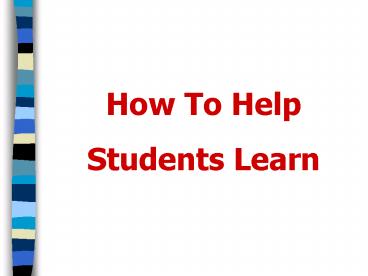How To Help Students Learn - PowerPoint PPT Presentation
1 / 39
Title:
How To Help Students Learn
Description:
4. Erase two other words in each sentences and ask them to ... 5. Keep on erasing words and at the end check if your students can remember all the sentences. ... – PowerPoint PPT presentation
Number of Views:19
Avg rating:3.0/5.0
Title: How To Help Students Learn
1
How To Help Students Learn
2
MOTIVATION
3
Students need motivation to use the language as
often as possible.
4
How can students use the language spontaneously?
5
Opening, keeping, and closing a conversation
6
Learners who are encouraged to communicate are
likely to acquire a language faster and more
efficiently
7
What are key factors in keeping motivation?
8
Success and Satisfaction
9
Success depends less on materials, techniques
and linguistic analyses, and more on what goes
inside and between the people in the
classroom.(Earl Stevick, 1980)
10
How to motivate students?How to maintain
interest?
11
The nearer language teaching can come to real
life, the more interesting it will be.
12
Teachers should
- Create a nice atmosphere in the classroom
- Be interested in students as people
- Play their role as teachers very professionally
- Praise and encourage students
13
Teachers should
- Be honest
- Be creative
- Personalise
- Use students knowledge
- Look at all students in class
- Make sure that everyone is called on equally
14
Teachers should
- Be neutral and fair
- Be flexible
- Build confidence in their students
- Encourage the use of the language outside the
classroom
15
Teachers should
- Encourage good, not unclear or one-word replies
- Listen fully to students
- Vary their techniques for asking questions
- Limit their TTT. Maximise STT
16
Teachers should
- Take account of different levels within the class
- Be careful how they put people together in a
classroom - Deal with individual problems after the class
- Give a time limit
17
Teachers should
- Correct their students systematically
- Make sure everyone knows the simple classroom
language - Use Pairwork / Groupwork as much as possible
18
Make sure you give clear, simple, and logical
instructions.
19
Pairwork / Groupwork
- Students have added support of a partner
- Takes the focus away from the teacher and makes
the lesson more student-centred - Gives students the opportunity to share ideas and
knowledge
20
Pairwork / Groupwork
- Gives students more speaking practice
- Allows shyer students to speak in a less
threatening environment - Fun and motivating for students
21
Pairwork / Groupwork
- Provides variety
- Helps students develop communication skills
- Gives the teacher the chance to listen to
students as they work
22
Material
23
Course for adult and young adult beginners and
false beginners
24
- The Teachers Manual provides very full lesson
plans for each unit.
25
- Present the target language
- Provide practice of the language
- Encourage creative application ofe the newly
acquired language
26
Standard Instructions
- Briefly review the previous lesson
- Use the context of the classroom
- Set up the situation
27
Listening Activities
- Listening to the teacher
- Listening to classmates
- Listening to himself
28
Speaking Activities
- Act out the conversation
- Listen and repeat
- Monitor Pairwork
29
Reading Activities
- Students are supposed to read everything that
appears in the students handout - Ask students to read silently, at their own speed
30
Writing Activities
- Copying from the board
- Exercises
- Dictation
31
MOTIVATING GAMES AND ACTIVITIES
32
THE LAST LETTER GAME
- Student 1 Twenty
- Student 2 Yellow
- Student 3 Wall
33
ASKING QUESTIONS
- São Paulo
- 2
- Eduardo
- January 16th
- 1986
34
WORD TENNIS
- Teacher fruit
- Team A bananas
- Team B oranges
- Team A strawberries
- Team B grapes
- Etc
35
TIC TAC TOE
- radio, dirty, winter, April, red, week, Sundays,
weekends, breakfast, garden, table, teacher,
nurse, car, water.
36
TIC TAC TOE
Radio
April
Winter
37
MEMORY GAME
- 1. Write on the board some pattern sentences you
want your students to learn. - 2. In pairs, ask them to read the sentences aloud
twice. - 3. Erase two words in each sentence. Ask students
to say the sentences trying to remember what was
erased.
38
MEMORY GAME
- 4. Erase two other words in each sentences and
ask them to try to remember the sentences. - 5. Keep on erasing words and at the end check if
your students can remember all the sentences.
39
edna.adell_at_ig.com.br































